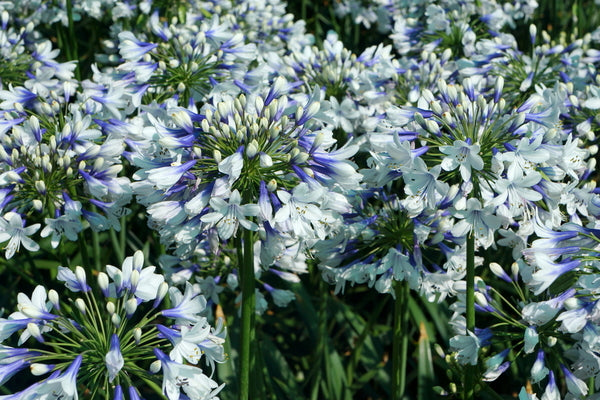Agapanthus, commonly known as Lily-of-the-Nile, is a stunning flowering plant that adds a touch of elegance and charm to any garden. With their graceful arching stems and striking clusters of blue, purple, or white blossoms, agapanthus are a favorite among gardeners, both experienced and novice. If you're a beginner looking to cultivate this beautiful plant, we've got you covered with a comprehensive guide on how to grow and care for Agapanthus plants.
Preparing the Flower Bed:
Before you start planting Agapanthus, it's essential to choose a suitable location that meets their requirements. Here's how to prepare the flower bed for your Lily-of-the-Nile:
Sunlight: Agapanthus thrives in full sun to light shade. Choose a spot that receives at least 6 hours of sunlight per day. Morning sun and afternoon shade are ideal.
Soil: Agapanthus prefer well-draining soil. Amend heavy clay or sandy soil with organic matter like compost to improve drainage and fertility.
Spacing: Plant Agapanthus bulbs or divisions about 18 to 24 inches apart to allow proper air circulation and growth.
Ongoing Care:
Once you've planted your Agapanthus flowers, it's important to provide consistent care to ensure healthy growth and vibrant blooms. Here are some tips for ongoing care:
Watering: While Agapanthus is relatively drought-tolerant once established, regular watering during the growing season (spring to early fall) is crucial. Water deeply when the top inch of soil feels dry, but avoid overwatering to prevent root rot.
Mulching: Apply a layer of organic mulch, such as straw or wood chips, around the base of the plants to retain moisture, suppress weeds, and regulate soil temperature.
Fertilization: Feed your Agapanthus with a balanced, slow-release fertilizer in early spring. You can also provide a phosphorus-rich fertilizer to encourage blooming.
Deadheading: To prolong the blooming period, remove faded flower stalks by cutting them back to the base of the plant.
Propagation:
Agapanthus can be propagated through division, making it a great option for expanding your garden or sharing plants with friends. Here's how to propagate your Lily-of-the-Nile:
Division: Every few years, dig up mature Agapanthus clumps and carefully divide them into smaller sections. Replant the divisions at the same depth as the original plant.
Timing: The best time to divide Agapanthus is in early spring, just as new growth begins.
Agapanthus 'Ellamae'
Agapanthus Varieties for Beginners:
For beginners, it's advisable to start with hardy and easy-to-grow Agapanthus varieties. Here are a few options to consider:
Agapanthus 'Ellamae'
This Lily-of-the-Nile variety forms a large clump of strap-like green leaves and boasts impressive midsummer blooms of dark blue-violet flowers on tall stems, resembling the tale of Jack and the Beanstalk. This variety consistently shines in field trials, particularly thriving after cold winters.
Agapanthus 'Twister' PP 25,519
Agapanthus 'Twister'
This robust Lily-of-the-Nile is the result of extensive breeding between Agapanthus praecox subsp. orientalis and Agapanthus campanulatus. It forms semi-deciduous clumps with 1-foot long leaves. In mid-June (NC), it produces tall 4-foot stalks bearing clusters of tubular bicolor flowers, featuring white tips and a violet-blue base, each measuring 7 inches wide.
Agapanthus 'Galaxy White' PP 31,431
Agapanthus 'Galaxy White'
This amazing agapanthus is a recent addition from Walters Gardens' breeding program, known for its remarkable resilience in harsh winters and impressive floral display. It has excelled in both heat and humidity trials. This selection begins flowering in early July (Zone 7b). The visual impact of Agapanthus 'Galaxy White' in a summer garden is truly breathtaking.
Lily-of-the-Nile Companion Plants:
Enhance the beauty of your Agapanthus by pairing them with suitable companion plants that complement their summer blooms. Here are some options:
Lavender: The fragrant blooms of lavender contrast beautifully with the vibrant colors of Agapanthus.
Salvia: The tall spikes of salvia add vertical interest and come in a variety of colors that can harmonize with Agapanthus flowers.
Daylilies: These hardy perennials offer a range of colors and bloom shapes, creating a stunning contrast alongside Agapanthus.
In conclusion, Agapanthus, or Lily-of-the-Nile, is a fantastic choice for beginner gardeners looking to add a touch of elegance to their outdoor space. By following the tips outlined in this guide, you'll be well on your way to successfully growing and enjoying the beauty of Agapanthus blooms year after year. Happy gardening!

